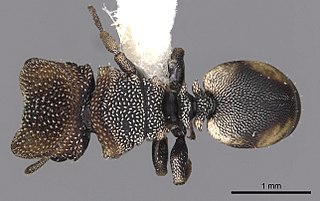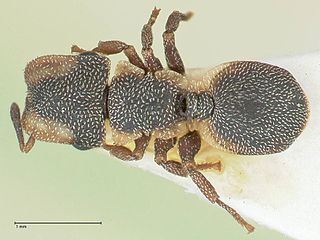
Cephalotes is a genus of tree-dwelling ant species from the Americas, commonly known as turtle ants. All appear to be gliding ants, with the ability to "parachute" and steer their fall so as to land back on the tree trunk rather than fall to the ground, which is often flooded.

Cephalotes atratus is a species of arboreal ant in the genus Cephalotes, a genus characterized by its odd shaped head. These ants are known as gliding ants because of their ability to "parachute" by steering their fall if they lose their footing.

Cephalotes adolphi is a species of arboreal ant of the genus Cephalotes, characterized by an odd shaped head and the ability to "parachute" by steering their fall if they drop off of the tree they're on. Also known as gliding ants. The species is native of Peru and of the Brazilian states of Goiás, Mato Grosso and Minas Gerais. Their larger and flatter legs, a trait common with other members of the genus Cephalotes, gives them their gliding abilities.

Cephalotes depressus is a species of arboreal ant of the genus Cephalotes, characterized by an odd shaped head and the ability to "parachute" by steering their fall if they drop off of the tree they're on. Giving their name also as gliding ants.

Cephalotes fiebrigi is a species of arboreal ant of the genus Cephalotes, characterized by an odd shaped head and the ability to "parachute" by steering their fall if they drop off of the tree they're on. Also known as gliding ants.

Cephalotes jansei is an extinct species of arboreal ant of the genus Cephalotes, originally erroneously called Exocryptocerus jansei by its discoverers, characterized by an odd shaped head and the ability to "parachute" by steering their fall if they drop from a tree, giving them the nickname of gliding ants. The species was probably native of Hispaniola, however, lack of more evidence makes this uncertain. Their larger and flatter legs, a trait common with other members of the genus Cephalotes, gave them their gliding abilities.

Cephalotes jheringi is a species of arboreal ant of the genus Cephalotes, characterized by an odd shaped head and the ability to "parachute" by steering their fall if they drop off of the tree they're on. Giving their name also as gliding ants.

Cephalotes kukulcan is a species of arboreal ant of the genus Cephalotes, characterized by an odd shaped head and the ability to "parachute" by steering its fall if it drops from the tree it is on, hence the alternative name of gliding ants.
Cephalotes maya is an extinct species of arboreal ant of the genus Cephalotes, characterized by an odd shaped head and the ability to "parachute" by steering their fall if they drop off of the tree they're on. Giving their name also as gliding ants. The species was probably native of the Mexican state of Chiapas, however, lack of more evidence makes this uncertain. Their larger and flatter legs, a trait common with other members of the genus Cephalotes, gave them their gliding abilities.

Cephalotes minutus is a species of arboreal ant of the genus Cephalotes, characterized by an odd shaped head and the ability to "parachute" by steering their fall if they drop off of the tree they're on. Giving their name also as gliding ants. The species is native of a large part of Central and South America, from the Argentinian region of Corrientes in the south, to the Mexican state of Tamaulipas, even to the American state of Texas in the north, making it one of the species with the largest native area of its genus. Their larger and flatter legs, a trait common with other members of the genus Cephalotes, gives them their gliding abilities.
Cephalotes olmecus, also known as the gliding ant, is a species of arboreal ant of the genus Cephalotes. It is characterized by an oddly-shaped head and the ability to "parachute" by steering its fall after dropping from trees.
Cephalotes pavonii is a species of arboreal ant of the genus Cephalotes, characterized by an odd shaped head and the ability to "parachute" by steering their fall if they drop off of the tree they're on. Giving their name also as gliding ants.

Cephalotes pinelii is a species of arboreal ant of the genus Cephalotes, characterized by an odd shaped head and the ability to "parachute" by steering their fall if they drop off of the tree they're on. Giving their name also as gliding ants.

Cephalotes targionii is a species of arboreal ant of the genus Cephalotes, characterized by an odd shaped head and the ability to "parachute" by steering their fall if they drop off of the tree they're on. Giving their name also as gliding ants.
Cephalotes toltecus is a species of arboreal ant of the genus Cephalotes, characterized by an odd shaped head and the ability to "parachute" by steering their fall if they drop off of the tree they're on. Giving their name also as gliding ants.
Cephalotes ventriosus is a species of arboreal ant of the genus Cephalotes, characterized by an odd shaped head and the ability to "parachute" by steering their fall if they drop off of the tree they're on. Giving their name also as gliding ants.
Cephalotes biguttatus is a species of arboreal ant of the genus Cephalotes, characterized by an odd shaped head and the ability to "parachute" by steering their fall if they drop off of the tree they're on. Giving their name also as gliding ants. A member of the multispinosus clade differing from its outgroup species by the presence of gastral spots and from the two ingroups by the superficial sculpture of the worker and soldier, and, in the soldier only, by the absence of cephalic disc.

Cephalotes clypeatus is a species of arboreal ant of the genus Cephalotes, characterized by an odd shaped head and the ability to "parachute" by steering their fall if they drop off of the tree they're on. Giving their name also as gliding ants.
Cephalotes jamaicensis is a species of arboreal ant of the genus Cephalotes, characterized by an odd shaped head and the ability to "parachute" by steering their fall if they drop off of the tree they're on. Giving their name also as gliding ants. The species is native in Jamaica, the specimen that lead to its discovery was found in Kingston Their larger and flatter legs, a trait common with other members of the genus Cephalotes, gives them their gliding abilities.
Cephalotes opacus is a species of arboreal ant of the genus Cephalotes, characterized by an odd shaped head, and the ability to "parachute" by steering their fall if they drop off of the tree they're on. Giving their name also as gliding ants.










